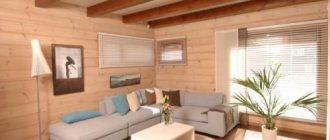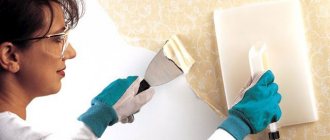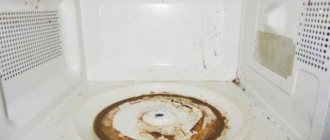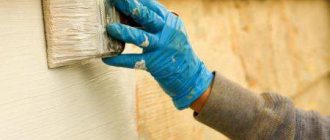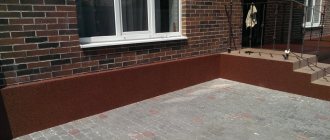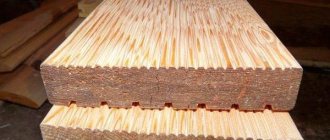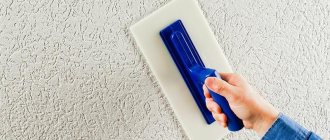The main features of choosing surface coating products
There can be a lot of processing options. It is important to choose the most reliable ones, which are ideal, taking into account both the size of the owner’s wallet and the aesthetic appearance. In this section, we propose to study the most alternative materials for outdoor painting of lining.
Standard oil based paints
This coating is suitable for wood cladding; it penetrates quite deeply into the base, thereby creating a protective layer that will prevent moisture from getting into the cracks and, as a result, the formation of fungus and mold.
The paint’s resistance to temperature changes and prolonged exposure to ultraviolet radiation is also noted. Despite this durability, the paint needs to be renewed from time to time. It is enough to re-apply the composition to the same layer without first preparing the surface. This will give even greater reliability to the paintwork.
Oil paint is characterized by a long drying time, which is not a very convenient property, and therefore dust and small debris cling to the sticky layer.
Oil paint to create a protective layer for lining walls with clapboards on the street Source petrovich.org.ua
On a note! It is better to use oil paint for finishing carriage street material when the country house building is located in a shady area.
Antiseptic compounds
With the help of antiseptics, it will be possible not only to refresh the lining on the facade of the house, but also to protect it from the effects of harmful microbes. Also, insects and rodents will not be able to penetrate into the small cracks of the wood, because the composition of the finishing material has a pest-repellent odor.
Antiseptics also reliably protect the coating from sunlight and prevent cracking and drying out of the wood. Such compositions are quickly absorbed due to their light consistency.
Only the antiseptic composition has a main negative feature - it is opaque. Therefore, you will have to forget about the visibility of the wood structure on the surface of the walls. Therefore, it is recommended to give preference exclusively to glazing materials if you want to preserve the appearance of the tree.
Wood antiseptic as a means of coloring lining Source neoasept.ru
Using the latest means, you can not only preserve the porosity and wood grain, but also emphasize it and make it stand out against the background of the facade. Glazing compounds help prevent the appearance of rot and preserve the appearance of the material when exposed to negative climatic conditions.
Acrylic paint compositions
When applying acrylic paints to the lining, it is possible not only to preserve the performance properties of the wood material, but also to emphasize its appearance. This composition is considered environmentally friendly, unlike oil-based ones, and retains its color many times longer.
Acrylic paint for wood is very flexible, so even if the walls of the house shrink strongly, it will not crack, but will continue to maintain the attractive appearance of the walls. Applying acrylic to wood is very easy, plus it lasts longer. The product is vapor-permeable, due to which condensation will not heat up inside under a layer of paint or inside the lining.
Alkyd varnish
Alkyd varnishes are available in a wide range, but you need to know how to work with them in order to ultimately get a perfectly smooth and beautiful coating on the facade of a country house. The material has positive performance properties: it has a high level of protection from moisture and is considered durable.
After drying, it withstands exposure to sunlight, practically does not fade and retains the structure of the carriage wood material. The traditional service life of alkyd varnishes of acceptable quality is more than ten years, provided that the composition is applied correctly.
Alkyd varnish for clapboard cladding Source onlinetrade.ru
Important! Any alkyd varnish must be applied in a strictly thin layer. Otherwise, it will start to wrinkle. You can try re-coating only after the previous layer has completely dried.
Ship or yacht paint and varnish composition
Yacht varnishes themselves are quite expensive, but work well when applied to wood. The surface of the external surfaces of the house acquires an additional protective layer that is not afraid of temperature changes, sun exposure, and moisture.
After application, the varnish reliably protects the lining from yellow spots that so often occur during standard coloring of the material. It also has a minimal drying time - no more than 3-5 hours.
Coloring protective composition for yachts, which is suitable for wood lining Source irecommend.ru
The proposed compositions are offered in different shades, despite the fact that they are translucent. Therefore, you will have to choose the right one taking into account the color of the facade.
Waxes
To decorate and protect wooden panels, you can also use a material such as wax. It can be solid, liquid or aqueous. As for the first, it is heated to a liquid state before being applied to the prepared wooden surface.
The second and third modifications are used in the form in which they are sold. After application, the wax helps create a protective layer, but only if it is applied evenly to the previously prepared surface.
Reasons for processing panels
Most buyers of wood material are simply confident that it does not require additional processing and can be used in its original form, that is, in the form in which they purchased it.
This opinion, as you yourself understand, is erroneous, because this method of using wood is short-lived, especially since the untreated material will simply lose its original appearance very quickly.
But if you look far into the past, it becomes known that people from very ancient times covered wood with various compounds in order to protect it from external influences and factors.
Our ancestors knew how to reliably protect natural materials
The material that is used for exterior decoration especially needs treatment, because it is under constant influence of various unfavorable factors: wind, sun, precipitation, temperature changes, pest invasion, which are just waiting for the owner of the wooden structure to solve it. process.
All these factors can lead to:
- rotting;
- covered with mold;
- swelling;
- burnout under direct sun;
- covering the surface with fungi and bacteria;
- loss of its original appearance.
If the lining you purchased is made of coniferous wood, then when the temperature increases, it will begin to release resins. This process can lead to spontaneous combustion and various types of burns.
If the processing of wooden lining is carried out correctly, all of the above consequences are simply not scary for it. This procedure is the key to a durable structure that will last a long time and will not lose its original appearance. Processing of panels is carried out in several stages, which we will consider below.
Subtleties of choosing a coloring composition
Before finishing, it’s not enough to know how to paint the lining on the outside of the house; you also need to choose the right composition. To do this, it is recommended to take into account the following nuances:
- take into account the climatic conditions in the region where the country house is located;
- know the properties of wood that is used for lining;
- study the labeling on the packaging (resistance to moisture and temperature changes must be stated);
- The warranty period from the moment of drying is at least 5 years.
By observing these simple conditions, you can purchase a high-quality composition that will pay off over the years.
Paint color options for wooden street finishes Source torinaimage.pw
Important! If, from the moment of initial application of the coloring composition on the street paneling, a period equal to the warranty has not passed, the owner has every right to contact the store where he bought the composition to compensate for financial damage or purchase a new high-quality composition. This outcome is only possible if the purchase receipt is kept.
Types of preparatory work
The ideal option would be to immediately paint freshly installed wooden paneling on the outside of the house. But in practice this is rare. There are definitely factors of time, and sometimes sloppy previous painting. Paint peeling off in rags, an overdried surface, areas affected by rotting - all this is often present on the outside of the walls of houses where the painting was done poorly or was not done at all.
The old lining needs to be prepared for painting - remove any remaining paint, soak it with an antiseptic
Therefore, before you start painting, the lining needs to be treated. The work is simple, but quite labor-intensive. The following steps need to be completed:
- Cleaning. The surface is passed with a brush, and if necessary, to remove areas destroyed by rotting - with a scraper. All dust and dirt are removed. If there is old paint, it is disposed of with special care. After this, the surface is washed with a soda solution of a sufficiently high concentration - approximately 0.3 kg of soda per 10 liters of hot water.
- The destroyed areas are replaced with new strips of clapboard.
- A separate stage should include the fight against existing mold. To do this, there are many special products on the market that need to be used to treat the walls outside the house.
- For better paint adhesion, you can additionally degrease the surface using detergents containing alkali.
- Grinding in progress. Power tool owners will find a better way to use the power of what they have at their disposal. Others can resort to using simple pumice.
- You can skip the primer with special compounds that prevent the growth of bacteria, fungus and mold. However, if you want to get a truly durable coating on the outside of your home, it’s better to do this. Then it will be easier to paint and the coating will be of the highest quality and durability.
After carrying out the entire complex of measures, you can paint the surfaces or coat them with various compounds. Which option for treating the walls outside the house to choose is up to each individual to decide.
Coloring procedure from A to Z
When starting to paint a facade made of lining, you need to divide the work into several stages. In this section we suggest that you familiarize yourself with them.
Preparation
The first and most important thing is to properly prepare the wood for painting. To do this, you must initially carry out revision work and inspect the surface for integrity, cracks, damage, the formation of rot or fungus, moss growths (this often occurs if the house is rarely used).
Preparation is always considered an important step, since painting a problematic surface is always accompanied by further problems: the paint layer may collapse prematurely or it will not perform its function correctly.
If there is contamination or damage by microorganisms on the surface, it must be treated with special compounds. Cracks will have to be sealed to prevent further damage under the cladding. It is also advisable to treat the places of joints, seams, and screw insertions with a sealant (and you need to choose a liquid, quick-drying composition. Silicone-based products are not suitable for this treatment).
Preparing the lining before painting Source twitter.com
Important! If you planned to paint the lining for tomorrow, but today it rained, then you should wait a while with finishing the facade. The lining must be completely dry, because the consequences of wet wood under painting can be very disastrous: the paint will swell, bacteria will begin to develop inside, and the color and aesthetics of the walls will deteriorate.
Painting options depending on the condition of the skin
There are several painting methods, which depend on the cladding material. The possible options are listed below:
- the lining is installed, is in good condition or has been brought to perfection by grinding. In such a situation, the coating is treated with a primer. It will highlight the style and structure of the wood. Subsequently it is varnished;
- the material was not sheathed immediately and the surface became gray. The surface is painted with preliminary putty, sanding and priming. In this case, you need to use impregnation from the same company as the coloring composition;
- The siding of the house is already old. Processing such a surface requires lengthy preparatory work. Without fail, the lining is treated with a biocidal primer, which has deep penetration. Afterwards the coating is painted. But, this option is only possible if the wood does not have major damage. Otherwise, a complete replacement of the material is needed.
On a note! When performing preparatory work before painting the lining, you need to treat other parts of the facade: shutters, window sills, canopies, if they are also made of wood. Then you can simply paint them a different color to make an accent.
Why is impregnation needed?
Some owners of private houses do not see the point in treating the surface of the lining with impregnations. In fact, if thin planks are not covered with anything, after a certain period of time, not the best changes will appear on them. If there is insufficient ventilation, the fitting will become covered with a peculiar blue color, and if it is intensively exposed to aggressive sun, it may become dark gray.
The procedure will not be the easiest or fastest, and will be accompanied by characteristic unpleasant odors.
If a grayish coating has appeared on the lining due to exposure to sunlight, then you can get rid of it by turning to mechanical grinding. But the positive effect of these procedures is unlikely to last for a long time. It is more advisable to resort to processing the finishing material immediately after its installation. In this case, problems can be avoided in the future.
Impregnations suitable for lining not only protect it from negative external factors, but also make it more aesthetically attractive. With this addition, the interior looks nicer and neater.
Important Tips to Follow
At first glance, the surface painting procedure may appear primitive. But, if the tips listed below are not followed, problems with the coating may occur during operation. Therefore, pay attention to the following points:
- temperature regime. The optimal air temperature should be no higher than 15 degrees;
- climate features. After painting and until completely dry, do not allow rain or other precipitation to get on the surface, otherwise the layer will be damaged;
- using a roller and brush. Such tools should be used in combination: the first for smooth surfaces, the second for hard-to-reach places.
For external processing, more aggressive paint and varnish compositions are used, so their use for internal finishing is extremely undesirable.
Painting external walls made of lining, carried out in dry weather Source gidpokraske.ru
Painting the balcony
In two-story country houses, the design often includes balconies and terraces. Their outer bases are also sheathed with carriage material. Since balcony areas on country seasonal houses are often not glazed, you need to choose harmless compositions for painting. This is due to the fact that when a person goes out onto the balcony, he will in one way or another inhale chemical vapors.
Therefore, here it is also important to know how to cover the outside of the lining. An alternative means is scuba diving, which contains only gentle ingredients. Here are some of them:
- EUROTEX. A high-quality paint and varnish composition that creates a protective coating that can repel moisture. The composition necessarily contains an antiseptic, as well as some components that form active sun protection. Features a wide color spectrum.
- "Belinka". A popular material characterized by increased resistance to ultraviolet radiation and humidity. Helps prevent the development of microorganisms and bacteria in wood, emphasizes the natural shade and structure of the lining. Moreover, no matter how many layers are applied.
- IMPRANAL. This composition not only reliably protects the wood coating, but also makes the facade walls more attractive and pleasant to the touch. This product is used not only for exterior work, but also for interior work, when the partitions of the room require constant wiping.
- Teknos acrylic varnish. An excellent composition that is not only capable of creating the aesthetics of a coating covered with clapboard, but also increases the degree of protection against mechanical influences. The final coating layer becomes vapor permeable.
The use of acrylic varnishes for facades is justified by their high reliability, but only if they are applied correctly.
Important! After applying the coating and during the first month of operation, detergents should not be used on external walls. There is a very high risk of damage to the finishing layer.
The lining on the balcony is painted with proprietary harmless compounds Source remontnik.ru
We process the balcony and loggia
A reasonable question arises: how to paint the lining on the loggia so that it is safe for health and at the same time durable and effective?
The most common answer is scuba diving. They perfectly protect wood, maintaining its original appearance. Here are a few options that are popular among the population.
Eurotex
- Contains an antiseptic that protects the tree from biological damage.
- Prevents color loss when exposed to ultraviolet rays.
- Forms a moisture-repellent coating.
- The texture of the wood remains visible, while a wide range of colors makes it easy to paint the lining to change the color of the walls on the balcony and in the living room where there is a wooden surface.
Various wood shades: there are a lot of options
How to beautifully protect lining indoors? Use tinted aqualac.
Application of special impregnations
It is easy to coat the lining outdoors with the help of professional impregnations. Among them, you can choose one of the following modifications of the compositions:
- VALTTI AKVABASE. The composition is a primer that is compatible with all types of wood. It contains oil components, as well as antiseptics. Ideal for treating exterior walls of a house, as it penetrates deeply into the wood. It is advisable to apply this impregnation immediately after finishing with a brush, carefully treating all areas. But, after it, it is advisable to also apply a layer of coloring composition, since the primer itself does not protect the wood coating from exposure to UV radiation;
- VALTTI AKVAKOLOR. It is characterized by deep penetration into the treated surfaces, preventing the appearance of blue stains, fungi and rot. Perfectly protects the structure from ultraviolet radiation. This composition is recommended to be applied in two or three layers. Before use, the wood must be treated with a brush or fine sandpaper for better adhesion to the impregnation;
- TIKKURILA. It comes in the form of azure, is easy to use, and is based on an oil composition. The product perfectly repels water, but it must be applied in the same way as the previous composition - in two or three layers;
- SENEZH. Impregnation from a Russian manufacturer that protects wooden surfaces from all kinds of pests and damage. Features a wide range of shades. You can choose an economical composition.
The impregnated lining should look like in this photo, perhaps lighter Source brigwood.com
Using these products, a rough protective coating is often created, and the finishing is done with special paints, which are listed in the sections above.
Selection of paint and varnish
Now, let’s return to the question of how to paint eurolining on the outside of the house and consider all the existing options for surface treatment.
Covering antiseptics
- Protect products from UV rays, microorganisms and high humidity.
- Absorbed deeply into the composition of the material.
The downside is that the product is opaque: the wood texture will no longer be visible.
Glazing antiseptics
- The transparent composition emphasizes the color shade, highlighting the wood texture.
- Protects against mold, rot and precipitation.
Note! Many antiseptics of this type cannot be used for subsequent painting, so be careful before purchasing. Also, most of them cannot be applied to old paint and varnish.
Oil paints
- Penetrates deeply into wood.
- Increases resistance to precipitation and moisture penetration into the material.
There are also negative qualities:
- Over time they lose color . Matting may occur, which will be noticeable in very bright shades.
- It takes a long time to dry : about several days. If there is strong wind and rain outside, and the facade of the house is not covered, then the painting work process was in vain.
Advice! Therefore, before painting the lining outside the house, take care to prepare large sheets of film with which you can cover the surface from dirt.
Acrylate paints
- They retain color much longer than oil-based ones.
- Over time, even with extensive shrinkage, houses do not crack.
- They are considered the most environmentally friendly of those materials that exist on the market.
- They create a dense film that prevents water from affecting the wood.
- Protects the material from mold and mildew.
Alkyd varnishes
The negative point is the dense composition, which does not allow the wood to breathe.
Yacht varnish
- Dries in 3 to 5 hours.
- Prevents yellowing of wood.
- Increases resistance to water and sudden temperature changes.
There is no exact answer to the question of what varnish to paint the lining on the walls and facades of a house, since the choice depends entirely on the wishes and capabilities of the buyer.
Homemade effective impregnation
Painting lining surfaces outdoors can be done with a product prepared at home. This method is the most cost-effective and simple. To prepare it, you need:
- 10 liters of water (bucket);
- 10 bars of soap, 200 grams each (preferably laundry or tar);
- 10 liters of drying oil.
Approximate shade of do-it-yourself impregnation Source onlinetrade.ru
The entire composition must be diluted exclusively in a galvanized bucket, otherwise its walls will be damaged. The process of preparing the impregnation consists of the following simple algorithm.
- Pour water into a container and rub all the pieces of soap into it on a fine grater.
- Place the mixture on the fire and cook for 15 minutes, then let it cool slightly.
- Separately, heat the drying oil to a temperature of 36-37 degrees, prepare a tank of 20-35 liters.
- Pour two components into it evenly: soap solution and drying oil, and mix the ingredients intensively until a homogeneous mass is formed. For quick mixing, you can use a whisk or special attachments on an impact drill.
- After obtaining a homogeneous consistency, the homemade impregnation can be considered ready. Cool it to about 20 degrees, and then apply it to the wooden wall using a roller or brush (as convenient).
The next day, weather permitting, it is necessary to cover the wall with the same slightly heated composition again. A hardened finish coat with homemade impregnation can last up to five years.
The facade of a clapboard house, protected by impregnation Source skachat-kartinki.ru
Preparation of products
Growing mushrooms at home, advantages and difficulties
First you need to inspect the lamellas, set aside those that have major defects: cracks, eyes and knots. They can be partially used by cutting off the defective piece.
Those panels that are suitable for installation should be cleaned of dust and dirt; sand it thoroughly with medium and fine sandpaper, simultaneously identifying the presence of possible areas that are already affected by fungus or mold. If such areas exist, they are treated with bleaching compounds.
It is advisable to carry out this procedure over all lining boards that will be installed, on both sides.
The following operations depend on how the problem will be solved - how to process the lining.
A few more words about painting
The most common method of painting wood surfaces is staining. This composition is sold in several different shades, and they remain translucent after application. This method of painting is considered the most budget-friendly, but not durable. The coating will need to be updated almost every year.
The quality of the applied layer depends not only on the work performed by the painter, but also on the appropriate product, both in composition and shade. Therefore, this point also needs to be paid attention to when purchasing.
Painting the lining using impregnation or drying oil will give the color as in the photo Source delta-lkm.ru
Why is it so important to paint the lining
Since lining is a natural material, there are much more pests for it. Therefore, in order to protect the tree, you need to protect it by painting. Negative factors that damage the casing are:
- change in humidity level. In this regard, serious deformation of the material occurs. For example, when it dries out, cracks begin to appear and the seams come apart. In the case of moisture absorption, the material becomes heavy and susceptible to infection by fungi;
- temperature changes in different seasons. This factor also affects the integrity of the skin; moreover, it will lose its attractive appearance, and it will be impossible to correct it;
- exposure to ultraviolet radiation. Such radiation spoils the coating, as a result of which it turns yellow, and over time the internal wood fibers are destroyed;
- the appearance of pests. Small insects or rodents often penetrate under the clapboard covering, creating holes and passages for themselves, thereby destroying the structure of the material.
To extend the service life of the material to the maximum, it is recommended to do the finishing immediately after installing the facade.
Treatment of lining from fungus and mold Source vsyavagonka.ru
What else is important to pay attention to
When choosing a coating composition, you should also take into account such factors as the material from which the lining is made. If previously the raw materials for cladding were made exclusively from different types of wood, now the basis can be based on various components. Among these are:
- MDF. This raw material must be painted in three layers when performing external work. An insulating primer is evenly applied to pre-prepared panels or beams, followed by filling the primer, and at the end the finish is covered with enamel. For uniform application of impregnations and coloring compounds on MDF, it is better to use a spray gun.
- PVC. Not every paint sticks to such surfaces. For these, you need to select products with special labeling. In most cases, polyurethane-acrylic water dispersions are used. They are considered environmentally friendly and contain no solvents. The resistance of such compositions to contamination is noted.
- Vinyl. Acrylic, quick-drying paints and varnishes are also used for such surfaces. Only in this situation it is better to choose models marked for outdoor use.
Video description
Painting the lining.
If the carriage material is made of spruce, pine, aspen, linden or alder, then all of the above-mentioned coloring agents that are intended for wood can be used for painting.
Processing of lining together with holding beams Source pokraskadomov-vergiz.ru
